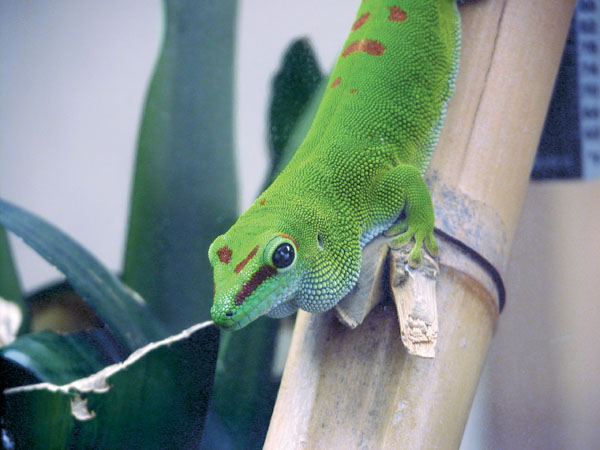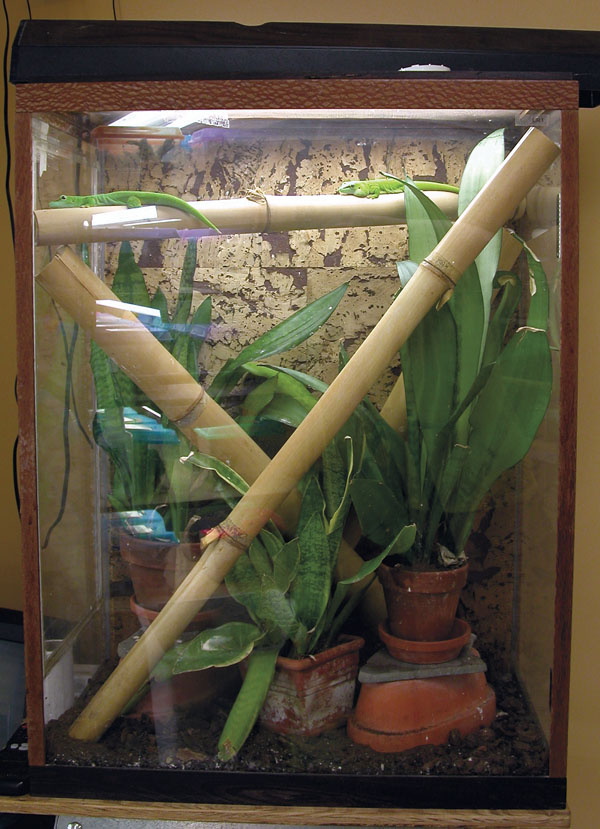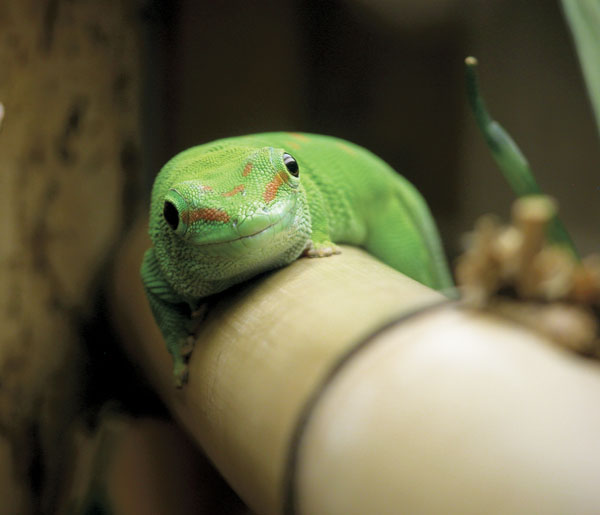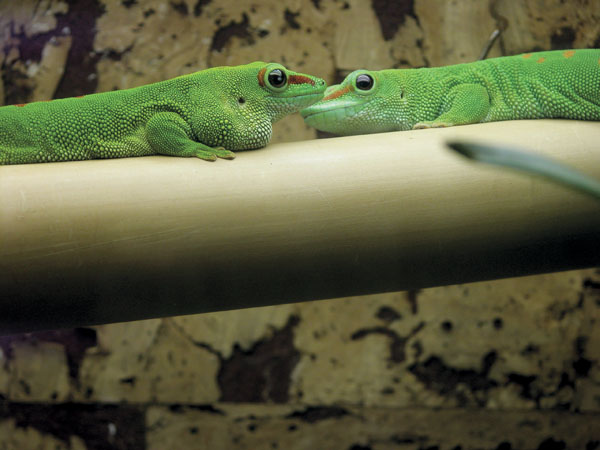The giant day gecko (Phelsuma grandis) possesses jewel-tone colors and an interesting personality to match.
Easily the most popular of day geckos, the giant day gecko (Phelsuma grandis) possesses jewel-tone colors and an interesting personality to match. These traits add to its irresistible allure and, along with the lizard’s grand size, contribute to crowning it the king of day geckos.
Described in 1870, the giant day gecko is native to Madagascar, an island in the Indian Ocean just east of Africa’s coast. This fast-moving gecko reaches 8 to 10 inches long with males averaging slightly larger than females. One of the larger geckos, the species typically lives up to 15 years in captivity. It favors the tropical forest areas in the north and northeast of Madagascar.

Photo by Leann and Greg Christenson
This gecko’s skin is soft and sloughs off easily as a defense mechanism. Although the lizards don’t like handling, geckokeepers can do so if they’re careful.
Unfortunately, much of giant day geckos’ native habitat has been lost to deforestation, forcing populations to move to newer locations to survive. Some groups now live close to human habitations in Madagascar. The species also has found new habitat in the United States. Wild populations originating from escaped and released specimens from the pet trade have become established in Florida.
Wild giant day geckos feed on a variety of insects from hard-shelled beetles to large, soft-bodied insects. They have even been seen eating smaller lizards, including juvenile giant day geckos. Attracted to flowering plants, they lick nectar and the juice from ripe fruit.
Giant Day Gecko Arboreal Habitats
Giant day geckos do well in captivity when maintained in a tropical vivarium. Humidity levels should be between 55 and 65 percent. This gecko is most comfortable in temperatures that range from 80 to 88 degrees Fahrenheit during the day with a basking light temperature just above 90 degrees. At night, temperatures can drop to the mid to low 70s. All of these parameters must be met while providing good air circulation. Always set up, test and measure the temperature, humidity and airflow before putting a gecko inside an enclosure.

Photo by Leann and Greg Christenson
To bring out this gecko’s best color, select lights with a color temperature of 5,000 Kelvin and a color-rendering index above 85.
Enclosures that cannot maintain the appropriate temperature ranges need supplemental heat sources. If daytime temperatures are too low, add another fluorescent light fixture, or add an additional basking light. If night temperatures drop too low, increase the ambient room temperature. If night temperatures still cannot be maintained in the lower comfort range, a final option is to install an undertank heater or heat strip. These devices warm the substrate and add to the enclosure’s overall temperature. An electric hot rock is never appropriate for a day gecko enclosure.
Provide this arboreal gecko with an enclosure more vertical than horizontal. Front-opening-door enclosures help reduce escape attempts; however, there is still no guarantee that a clever gecko won’t sneak through an opening.
A single giant day gecko can be comfortable in an enclosure measuring 11⁄2 feet long by 11⁄2 feet wide by 2 feet tall, but for pairs we would not recommend anything less than 2 feet long by 11⁄2 feet wide by 2 feet tall. A custom enclosure can be built to larger specifications, or a tall 20- to 30-gallon, top-opening vivarium is suitable.
Provide this gecko with lots of fixtures to climb upon. Bamboo and large pieces of bark make good basking or climbing places. Bamboo should be semivertical, and if it is hollow, it must be spacious enough so larger geckos can safely navigate in and out of the openings without becoming trapped.
Decorative backgrounds aren’t required, but they can be aesthetically pleasing. Some commercial companies produce realistic foam backgrounds that add to the environment’s appeal.
Several layers of substrate can help maximize vivarium humidity. Start with a three-fourths-inch layer of clean pebbles, cover them with 1 inch of orchid bark or commercial reptile bark, and then add enough organic potting soil to mix well into the bark.
Our favorite plants for giant day gecko enclosures include tall sansevierias, trailing pothos vines, orchids and bromeliads. Plants can be placed directly into the soil or in pots. Attach bromeliads and some orchids to the sides of the enclosure.
Although soil and plants are major factors in maintaining humidity in the giant day gecko enclosure, nothing can substitute for two or more daily mistings. We recommend reverse-osmosis or filtered water. Keep in mind that filtered and unfiltered water can eventually leave unsightly mineral deposits on the vivarium sides. Remove them with a light solution of reverse-osmosis water and vinegar.
Giant day geckos possess soft, easy-to-tear skin, so handle them with extra care. First-time keepers unfamiliar with how to gently handle the species may get a handful of green flesh. This skin-release defense mechanism helps the geckos escape predators in the wild, but owners should be aware of its drawbacks. Although the skin grows back, it is generally lighter in color, not as heavily scaled and noticeably different than the original skin. Likewise, the gecko’s tail can regenerate if a part falls off, but it also appears smaller and noticeably different than the original.
Giant Day Gecko Lighting
Giant day geckos are sun-lovers, so high-quality lighting is important. Lights with a color temperature of 5,000 Kelvin and a color-rendering index above 85 bring out this gecko’s best color. Lighting can also provide UVB and heat.

Photo by Leann and Greg Christenson
A giant day gecko basking under a light. Giant day geckos are sun-lovers, so high-quality lighting is important.
Luckily, many new bulbs made for reptiles on the market can meet one or more of those purposes. Compact fluorescent bulbs do an excellent job providing high-quality light, and many emit UVB. This type of ultraviolet light is used for some diurnal reptiles maintained indoors to help their bodies produce vitamin D3. Without this vitamin, these reptiles fail to absorb dietary calcium, which can result in secondary hyperparathyroidism. Giant day geckos are one of these reptiles. If they live indoors, they need UVB lighting to maintain their health.
Select a UVB light suitable for the enclosure. Follow manufacturer’s recommendations for bulb replacement, which is often every six months. A UVB-producing bulb needs to be between 6 and 12 inches from the gecko’s basking area to be effective.
If providing UVB light isn’t possible for some reason, there is an alternative, but it’s best left to experienced geckokeepers. Phelsuma species, including giant day geckos, can be maintained in captivity without UVB lighting if they are supplemented with sufficient dietary calcium and vitamin D3. Keepers can increase a gecko’s dietary calcium and vitamin D3 at each feeding, thus replacing the need for UVB lighting.
However, gecko keepers who chose this method should avoid vitamin supplements with high levels of vitamin A. Excessive vitamin A can inhibit the gecko’s body from absorbing calcium. One commercial supplement we use that provides the required vitamin D3 and calcium suited to this method is Rep-Cal Phosphorus-Free Calcium With Vitamin D3. Mix it with Herptivite in a 2-1 ratio respectively. Bright, high-quality lighting is still a must for giant day geckos maintained with this method because it helps them develop good color and stimulates natural behaviors.
New gecko keepers may not want to attempt this no-UVB-light method until they are fully versed in reptile husbandry, advanced lighting and reptile nutrition.
Sometimes UVB-emitting bulbs don’t provide enough heat to reach the high end of a giant day gecko’s comfort range, so an additional light for basking may be necessary. Incandescent bulbs in domed housing are typically used for basking lights, but halogens are also used in the reptile community. Halogens do an excellent job of producing heat. Place a basking light over an area where the gecko can sit and thermoregulate. To ensure that the amount of heat is appropriate, check the basking area with a thermometer.
Giant Day Gecko Diet
Captive giant day geckos can enjoy a variety of insects and fruit-nectar substitutes. In the United States, crickets make up the staple insect diet, but locusts are Europe’s primary insect of choice. Other insects that add variety to a gecko’s diet include superworms, captive-raised cockroaches, silkworms, butter worms and waxworms. The general rule is that the insect be smaller than two-thirds the size of a gecko’s head, be easily digested and be raised in captivity.

Photo by Leann and Greg Christenson
Besides insects, giant day geckos consume fruit nectars in the wild, and these can be easily substituted in captivity.
Collecting wild insects requires careful consideration of the area they were captured. Any insects caught near human-disturbed areas run the risk of being contaminated by herbicides, insecticides or toxic chemicals. Purchasing captive-raised insects removes these worries.
Purchased feeder insects may arrive gut-loaded and ready to be fed, but their nutritional value drops noticeably within 24 hours. Geckokeepers need a gut-loading program for their feeder insects if they plan to keep crickets for more than one feeding. For the best nutritional value, a feeder insect should be fully gut-loaded six to 24 hours before being fed to a giant day gecko. Dust crickets with an appropriate reptile vitamin with suitable levels of calcium, vitamin D3, and other essential vitamins and minerals before feeding it to the lizard.
Besides insects, giant day geckos consume fruit nectars in the wild, and these can be easily substituted in captivity. Choices include several commercial fruit substitutes or fruit baby food, such as Gerber stage-two peach, banana and apricot.
Commercial day gecko foods are available, and some are labeled as complete replacement diets, which suggests that they can be fed alone instead of a diet of insects and fruit nectar. Most are enhanced with vitamins and calcium that day geckos need. Occasionally some of these geckos reject commercial diets, but the food can be made tastier by mixing in some fruit baby food.
We have found that a natural diet including insects is much more beneficial to the overall well-being of captive giant day geckos. Commercial diets do a good job of making the natural diet more nutritional.
A suitable diet for this gecko is three to five appropriately sized crickets presented twice weekly and fruit baby food mixed with a commercial nectar substitute once a week. Juveniles and breeding females should be fed five to seven times weekly. Breeding females should have a bowl of calcium in their enclosures, but this bowl isn’t necessary if they’re not breeding.
Giant Day Gecko Color Varieties
With a large fleshy body, deep-emerald-green colors, orange-to-red lateral spotting and a characteristic red stripe from nostril to eye, the giant day gecko is a visual symphony. Today, thanks to captive-breeding projects, variations to the typical markings are available.
One popular color enhancement, the crimson grandis, was developed by Kurt and Melissa Lantz of the Rep Room. Developed in 1997, the line is described as hypererythrism with excessive lateral red back-spotting. Successive generations have developed red spotting into the sides, head and tail, and red banding across the back. Unlike normal giant day gecko hatchlings, which eventually lose their baby colors, hatchling crimson grandises look similar to the adults.
Hydrating Giant Day Geckos
Giant day geckos maintain hydration from the humidity in their enclosures and water they ingest. Most don’t learn to drink out of water bowls, so they need to have water drops to lap up. Twice-daily misting creates both the water source for the droplets and enclosure humidity.
Drip water systems and waterfalls can enhance humidity in the enclosure, but they are not a substitute for meeting this gecko’s hydration needs. Geckokeepers who wish to use these systems can experiment and measure results to see if they can set up a suitable system. Given the right environment and care, the giant day gecko is a rewarding captive that will provide its keeper with enjoyment for years to come.
Just Grandis
Recently the giant day gecko underwent a taxonomic name change from Phelsuma madagascariensis grandis to Phelsuma grandis. The change moves it to nominate species status (perhaps making it “king” in its own right). However, even with the name change, it is still commonly called the giant day gecko and less often “grandis.”
Read More:
Quality printed resources and cited references:
1. Christenson, Leann and Greg. 2003. Day Geckos in Captivity. Living Art Publishing, Ada, Okla.
2. Hallman, Kruger, Trautmann. 1977. Faszinierende Taggeckos. Natur und Tier Verlag, Matthias Schmidt, Munster, Germany.
3. Bergman, Julie. 2006. Geckos. Lumina Media, LLC, Irvine, Calif.
4. Henkel, Friedrich Wilhelm, and Wolfgang Schmidt. 2003. Geckos. Edition Chimaira, Frankfurt, Germany.
5. Raxworthy, C.J., C.M. Ingram, N. Rabibisoa and R.G. Pearson. 2007. “Applications of Ecological Niche Modeling for Species Delimitation: A Review and Empirical Evaluation Using Day Geckos (Phelsuma) from Madagascar.” Systematic Biology. 56: 907-923.


